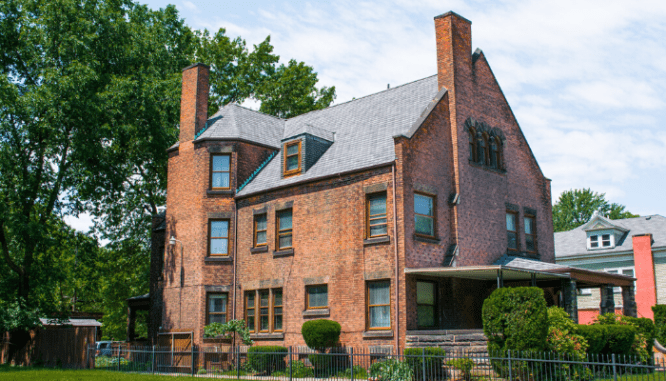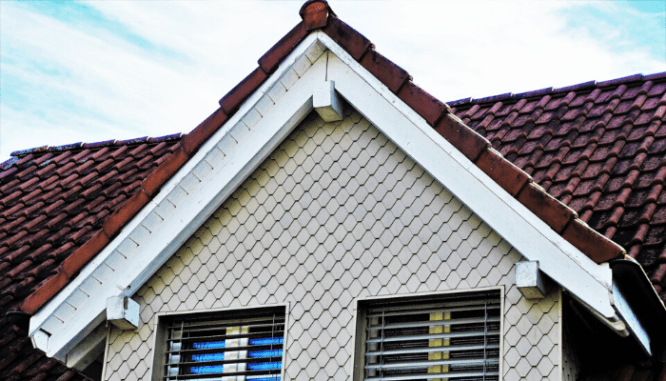Buying a House in Cleveland, Where You’ll Find Great Deals and Historic Gems
- Published on
- 5-6 min read
-
 Laura Leavitt Contributing AuthorClose
Laura Leavitt Contributing AuthorClose Laura Leavitt Contributing Author
Laura Leavitt Contributing AuthorLaura Leavitt is a freelance writer and editor who has written about real estate and home-related topics since 2017, in addition to writing about travel, small businesses, and sustainability topics. She owns her own 112-year-old home in Ohio.
This is an exciting time to buy a house in Cleveland. With an award-winning theater district, a growing food scene, and burgeoning technology and healthcare industries, this city has a ton to offer but remains an incredibly affordable place to live. Cleveland lands at 72.6 on the cost of living index (where the national average is 100) and has an astoundingly low median owner-occupied home price of $67,600 as of 2017. However… don’t expect buying a home here to be a cake walk.
“Now is one of the most difficult times to buy in recent history,” says Michael Thies, a top-ranking agent in Cleveland. “There hasn’t been enough inventory available. If you find a nice, renovated house in a hot neighborhood, you’ll be getting six or seven people bidding on it.”
We talked to Cleveland housing experts with decades of experience in home inspections and real estate and researched 58 local neighborhoods to give you the best chance at a successful house hunt. Here’s everything you need to know to buy a home in Cleveland and make the home of the Rock and Roll Hall of Fame your greatest hit.

Understanding the affordability of the housing market in Cleveland
Cleveland’s housing market remains one of the most inexpensive among major metropolitan areas. It is one of the seven United States cities with the most homes available under $100,000.
Some of these homes, though, are in need of major repairs due to neglect over the years, so it can still be a hunt to find the right gem. And if you want to shop for a home in a popular neighborhood with sought-after renovations like kitchen and bathroom remodels, be prepared to face some competition.
Compared to high-cost cities like New York and San Francisco, your bidding wars will still be relatively tame, with homes in sought-after neighborhoods of Cleveland going for prices in the $180,000s as of 2019.
However, it is important to talk to your buyer’s agent about recent listing and sales data in the area and make sure you don’t lowball an offer, since you could lose out on a great house opportunity if you quibble over a few thousand dollars. If the bidding war gets intense and you are asked to increase your bid multiple times, make sure you keep doing your comparisons to other available homes; there should be a point where you are happy to walk away.
Pad your Cleveland homebuying budget with a little extra for maintenance, property taxes, and insurance
When you are putting together your Cleveland home-buying budget, you’ll want to start with HomeLight’s Simple Home Affordability Calculator, set to “Cleveland, OH.” This calculator gives you what you need to budget by taking your conditions — estimated down payment, monthly mortgage payment, existing debts, and credit score — into account.
However, be aware that certain housing costs in Cleveland can bust your monthly budget faster than you can say “Let’s go, Cavs!” To keep costs down and account for any surprises, be sure to:
Factor in local property taxes
Local property taxes are specific to neighborhoods, villages, and townships, so being in the Cleveland metro area can result in varying property taxes. Cleveland proper has a property tax rate of 2.79%. Areas around Cleveland have rates that range from 1.75% in Cuyahoga Heights to 4.13% in Garfield Heights.
Plan for monthly and yearly maintenance
Maintenance costs may be higher than average in this part of Ohio and the United States in general. Cleveland gets heavy snowfall because it experiences the tail end of the “lake effect” snow. Snowfall is 54 inches per year, nearly double the national average, and Cleveland has 166 days of sun per year on average.
While this is ideal for walking in a winter wonderland, it means that sidewalks, driveways, and roofs take a beating. Budget for additional sidewalk and driveway crack-repair, a new roof every 18-25 years, and snow removal if you’ll need to leave the house during or right after blizzards. Want custom quotes for these expenses? Here are some local providers who have 4.4 or more average stars on their Google Reviews or Angie’s List:
Snow removal/salt:
Driveway crack repair and sealing:
Cleveland roofing companies:
Lastly, add in Cleveland home insurance premiums
Cleveland home insurance tends to be affordable because it is tied to the value of the homes, and on average, you’ll pay $813 on home insurance annually here. This price will vary, especially if you have a historic home: even if your home’s value is in the $100,000-to-$200,000 range, your insurance agent may recommend more insurance given that some of the materials, like beautiful hardwood floors and accents, cost much more to replace now.
Find Cleveland home insurance through these local companies, who all have an A+ rating from the Better Business Bureau:

Where to buy a house in Cleveland depending on your priorities and what you like
With a wide variety of in-town and suburban neighborhoods to choose from, Cleveland has 77.7 square miles of city-proper area alone. Here are some neighborhoods where you can start your search and find the right home for you.
For downtown, short-commute living
The following neighborhoods are experiencing growth, redevelopment, and even new home construction:
Ohio City
On the Near West Side of Cleveland, Ohio City has the walkability of any major city, as well as great weekend destinations like the West Side Market as well as a wide variety of craft breweries. You’re close to everything and many homes are either new or renovated, but there’s an associated mark-up — expect to pay $250,000 or more for a home in this neighborhood.
Detroit Shoreway
This west-side, lakefront neighborhood contains the Gordon Square Arts District, meaning you’ll never lack great restaurants, theater options, and arts programming. Similar to Ohio City, the quirky and fun homes that have been fully renovated in this area average around $200,000 to $300,000, and some go for quite a bit more.
Tremont
Come to Tremont for gorgeous Victorian homes and a cozy, urban-residential feel, and stay for small coffee shops, art galleries, and boutiques. Tremont has a wide variety of homes available, both at higher price points and those still in fixer-upper status for lower $100,000-to-$200,000 prices.
For traditional neighborhoods with great character and affordability
There are also areas of Cleveland proper that have a longstanding positive reputation, according to Thies, with low crime and affordable older homes available.
West Park
Originally a suburb that merged with Cleveland, West Park offers a diversity of higher-end, middle-price-range, and very inexpensive homes and a reputation for livability. Expect to pay less than in the most central districts, often under $100,000, but still be within easy commuting distance of most downtown businesses.
Old Brooklyn
This charming neighborhood contains the Cleveland MetroParks Zoo and is a great spot for families with kids. It’s getting more popular as a place for new businesses to set up shop, which means locals get the benefit of additional restaurants and boutiques. Most homes in the area are priced under $150,000, meaning that starting out here is a great deal, while still being well-located immediately adjacent to I-480 for commuting needs.
For a lakefront view
Another thing to consider is waterfront property. Development is growing along the Cuyahoga River. This area is now safe for fishing after years of recovery from industrial runoff during the 19th and 20th centuries. Lake Erie also has a variety of shorefront properties.
If you are shopping for lakefront property, however, make sure you understand the distinctions between access to the lake and views of the lake.
“Cleveland is almost built on a cliff. Every home on the lakeshore doesn’t have access to the lake,” explains Thies. “Housing is more expensive on the lake, but it is because of a lake view usually, though some properties have lake access or a beach.”

What to watch out for in Cleveland homes
“Cleveland is an area with a lot of older inventory, usually between 60 and 100 years old,” says Thies. We spoke with local home inspector James Jagger to know what kinds of red flags to look for. Jagger has completed more than 13,000 home inspections and has held office in the American Society of Home Inspectors. As you browse the options for your Cleveland home, make sure you keep your eyes peeled for these aspects:
Give the basement a close look
According to Jagger, 90% of the houses in Cleveland have basements, so the first and biggest thing to check carefully for is structural integrity and water entry in the basement.
Factor in the age of the HVAC
Many homes in the Cleveland area are equipped with dated HVACs. Most homes have natural-gas-fired, forced-air heating systems. Make sure to get a clear view of how old the system is, since replacement tends to be in the range of $8,000 to $9,000, according to Jagger.
An air conditioning unit over 10 years old and a furnace over 15 years are likely in their last five useful years. If this is the case, consider using this as a reason to ask for a reduced price. While you can use an old HVAC system as an opportunity to ask for an HVAC replacement, you may simply want to get the price cut and pick your own system.
Check for radon
Consider doing radon testing, since homes in this area sometimes need radon abatement.
Local home inspectors will either offer radon inspections themselves (James Jagger offers them as an additional inspection alongside the general home inspection) or can refer you to someone else who does radon inspections.
If high levels of radon are discovered, the EPA suggests mitigation if the test reveals a radon level of 4 picocuries per liter. You can either negotiate with the seller for a lowered price or ask them to complete the mitigation themselves, though a lower price is more common. Mitigation typically costs between $900 and $1,600, according to local radon abatement company SWAT Environmental.
Find out how old the roof is
When working with your inspector, make sure you ask them to pay special attention to the roof. Roofs in this area tend to last 18 to 25 years, according to Jagger. A home inspector can give you an estimate on the age of the roof based on its level of wear to within 3 and 5 years, if the age of the roof isn’t already disclosed by the seller.
If the inspection reveals a roof older than 18 years, request a drop in the asking price that would help offset the upcoming roof-replacement costs, which tend to be between $8,000 and $16,000, depending on the size and style of your home.
Seek out that historic gem
Looking to find a real winner in the market, something with great resale value down the road? Historic homes with beautiful hardwood and decorative exterior details are quite coveted in Cleveland.
You don’t have to live in the past with these houses, since many homeowners update their kitchens, bathrooms, and main floor living spaces for a modern design sensibility. Consider historic homes even if you know you want that contemporary open-plan dining room and living room.
“Back when these homes were built, the floor plans were a bit different, so anything you can do to open up a floor plan on the first floor makes that home a real winner,” says Thies.

Find the best time to buy a home in Cleveland
Want to spend some holiday gift money on a down payment? While there is no one best time to buy a home in Cleveland, the holidays in November and December tend to represent a slow time for the housing market, according to Thies.
HomeLight actually crunched local Cleveland transaction data and found that house shopping in January or February could be good opportunities for a deal, since homes selling in January sell for about 27% below average. February sales are about 14% below, but they also tend to take 44 days to sell, which indicates a softened market where you’ll have time to make a great purchase.
Partner with a top buyer’s agent in Cleveland
Getting a great buyer’s agent is a real value-add when buying a home in Cleveland. Your agent will understand the market and can tell when it is time to place a bid that is competitively over asking and when it is a good idea to start low for negotiation strength.
Top Cleveland buyer’s agents save clients, on average, $5,835 on their home price, and these top-performing agents facilitate 377 home purchases a year, as compared to a 72-home average for all agents in the area.
“Your agent offers the value of being an advocate, representing you in the negotiation of a property,” says Thies. “We know the neighborhoods, and we’re able to provide timely, accurate information about listings.”
Header Image: Source: (Sean Pavone/ Shutterstock)
